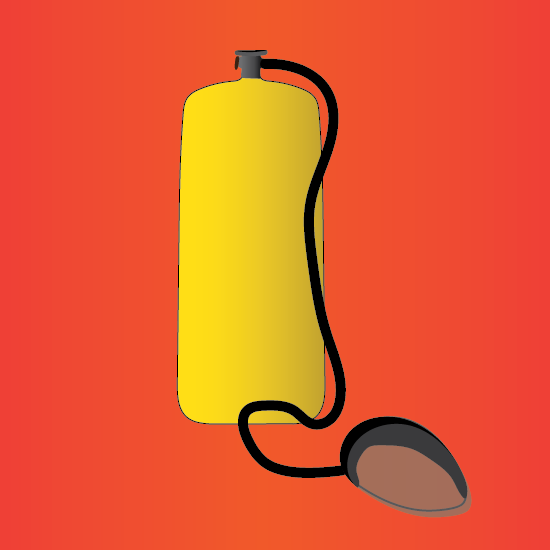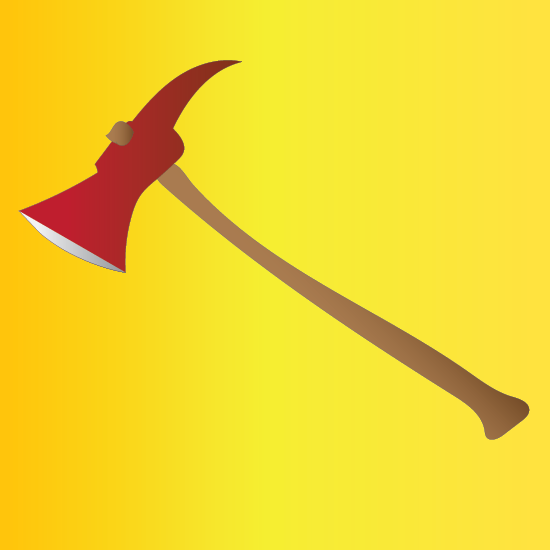The National Wildfire Coordinating Group glossary gives this definition of an anchor point:
An advantageous location from which to start building a fire break or line. If done properly, this will prohibit fire from establishing itself on the other side of an unsuspecting crew who could otherwise end up being surrounded, with little chance for escape.
The first thing you learn at fire school is the acronym, LCES. LCES stands for Lookouts, Communications, Escape routes, and Safety zones. You will repeat it to yourself while sharpening your Pulaski and your chainsaw. You’ll say it again while wearing your stiff new boots into the shower, and later when you hike up steep trails with your new crewmates, each of you carrying around 40 pounds of gear strapped to your backs in 100-degree temperatures. It’s printed on the back page of every firefighter’s pocket guide, and on stickers handed out, which will later show up on helmets, bunks, notebooks, and water bottles.
Next comes the video you’ll sit through at the beginning of every fire season until you retire. Short, low-budget clips featuring interviews with survivors of tragic fires. Close-ups of haunted faces recall having spent interminable moments pressed tight to the ground in their foil shelters taking shallow breaths, breathing prayers against the dirt to their families and Gods while roaring flame fronts consumed the oxygen outside.
The camera pans away from the faces of the survivors to several small, white, weathered crosses high on a lonely mountainside that soon fade to black, and you can practically taste the ash and smell the faintest whiff of burning flesh coming from the bodies of firefighters who lived just long enough to stop thinking or feeling anything.
You are going to need a mantra. Throughout your career, you will have many. “LCES’ is as good as any to start with. The “L” in LCES stands for “lookouts.”
Post a lookout, whenever there is a need for one. There is always a need for a lookout.
Now, if you can, imagine another kind of fire; the kind of fire that starts within a human being. Alcoholism is that kind of fire.
Trying to control alcoholism is as complex and harrowing as learning to fight wildland fire, and because I happened to undertake both labors at the same time, the lessons I learned from each informed the other until I eventually rose from the ashes of my former self.
Barely into my first fire season, I began to notice I was no longer able to rocket out of bed in the mornings after nights spent drinking with the crew, no matter how much water I drank or how hard I exercised in an attempt to sweat it out. I was tired all the time. At thirty-six, I was the oldest firefighter in a close-knit fire crew of twenty and thirty-somethings. Maybe I was just too old to be playing with fire.
Older though I was, I was the happiest I could remember having been because I had finally stumbled into the work I was born to do.
Still, the beginnings of more serious health problems related to my alcohol consumption began to show themselves and by autumn there was a persistent hollow ache in my stomach.
When you decide to stop drinking only to discover that your willpower can’t keep you stopped, posting the analog of a fire lookout is a good idea. Survivors of tragic fires and late-stage alcoholism each told me in the early days that retreating into a survival shelter to wait out the fire is a tactic one should never rely on. Sure, you might survive fire or early sobriety by insulating yourself from the world in a hot, airless cocoon, but the ultimate goal is to expand your world by developing healthy interdependence with others. Together and connected, everyone increases their chances of surviving whole and resilient, instead of suffering alone beneath a heavy blanket of smoky darkness.
The first step I took toward sobriety was accepting that the fire had been there for a long time, quietly burning my life down.
The “C” in LCES stands for communications. Many tragedies could have been prevented had supervisors listened to lookouts’ warnings, or if someone—anyone—had spoken up in time to retreat from oncoming disaster.
Similarly, many alcoholics could have avoided lost time and opportunities, and later grave injuries to health and relationships, if they had only listened when their friends and family told them, “we’re beginning to worry about you.”
Abstinence isn’t sexy, no matter which social media influencer decides to take a public journey on the wagon. Although moderating is no big deal for a person whose alcohol problem is minor or temporary, for a real alcoholic, “dry January” is edge play.
When I fully removed alcohol from my life, I suddenly felt skinless, with all my nerves exposed to the air wherever I went. My body and mind felt like riverbanks being overrun by waves of unprocessed grief and trauma. It was necessary to find or create alternative escape routes and safety zones until new pathways developed through my interior moonscape of fading fire scars, which at some point miraculously began to fill in with new green growth.
The “E” in LCES stands for escape routes. What is an escape route? In wildland firefighting, it’s simple: Pick two directions. Face the danger. Make sure your pathway is clear, even if you have to cut your own path through chest-high brush with your saw. When first becoming sober, finding an escape route seems impossible: Alcohol is everywhere, and it feels like a social mandate. Work, sports, vacations, and activities of every kind involve the ever-present friend that one must now treat like the traitor it has become.
At first, sobriety feels at once like a death of a best friend, loss of comfort, and a beloved version of one’s self. On some level, it is exactly these things; it is also another kind of deceptively simple escape route from the need to use a substance to deal with life’s pain. You’ve probably known people who have ultimately chosen one of the others; sickness, insanity, or death.
Phone numbers of friends who can be counted on to call back, and taking my own car to social gatherings were among the first and most effective escape routes and safety zones I developed early on. Years later, I still rely on them although recovery no longer is about the fear of drinking again. These days, I use my tools to help remain steady in a world that is often on fire and in an upheaval of its own.
The “S” in LCES stands for “safety zones.” Safety zones are meant to be large, well-considered areas easily accessed from the fireline, but in reality, they rarely are. On the ground and in life, crews learn to prepare the best they can with the resources and time they have.
When fighting fire, the last step is called cold trailing. I learned to take off my thick gloves designed to protect firefighter’s vulnerable hands from burns and feel for any remaining heat around the blackened edges of the former blaze where it bumps up against the green. Where heat is found, the hot dirt is dug up and spread, allowing it to cool. Unbelievable amounts of heat can be found sometimes in deep pockets of warm soil. All it takes is a breath of wind and one spark for a drowsing fire to be reawakened.
While I still occasionally stumble upon hidden hot spots in my sober life, it’s been many years since I’ve stopped trying to put my own fires out with alcohol. I regularly invite other seasoned sober people to help me cold trail the edges of the old burns. Together, we take up our collective tools and legacy knowledge to open up the haunted ground, exposing our still-smoldering secrets to sunlight and air. Somehow, this is how we stay sober.
It took years from the time I realized I wanted to be a wildland firefighter for me to begin to walk toward that goal, while also leaving the biggest obstacle to achieving it behind.
**
Voices on Addiction is a column devoted to true personal narratives of addiction, curated by Kelly Thompson, and authored by the spectrum of individuals affected by this illness. Through these essays, interviews, and book reviews we hope—in the words of Rebecca Solnit—to break the story by breaking the status quo of addiction: the shame, stigma, and hopelessness, and the lies and myths that surround it. Sisters, brothers, mothers, fathers, adult children, extended family members, spouses, friends, employers or employees, boyfriends, girlfriends, neighbors, victims of crimes, and those who’ve committed crimes as addicts, and the personnel who often serve them, nurses, doctors, social workers, therapists, prison guards, police officers, policy makers and, of course, addicts themselves: Voices on Addiction will feature your stories. Because the story of addiction impacts us all. It’s time we break it. Submit here.
***
Rumpus original art by Ian MacAllen







